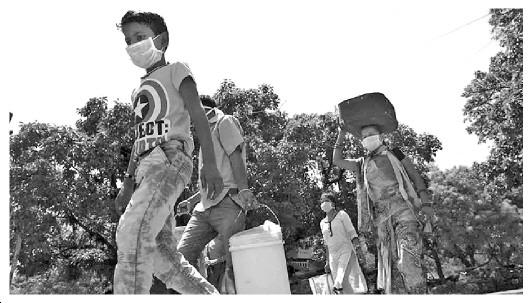Inflection point has not yet arrived
The picture shows in New Delhi, India, people wear masks to the train station to ride. India has implemented a national blockade for more than two months, but Indian experts believe that the peak of the epidemic has not yet arrived. Xinhua News Agency sends photo by Javed Dal
□ Our correspondent Li Yajun
On May 30, the Indian Ministry of the Interior announced that it would extend the national blockade measures it is implementing for another month to June 30. This is the fifth round of blockade policies adopted by India to contain the spread of the epidemic since the national blockade began on March 25. Since June, under the differentiated measures of the blockade of strictly regulated areas and the gradual liberalization of non-strictly regulated areas, India hopes to restore economic vitality while curbing the epidemic.
Stop the spread of the epidemic
According to statistics from Johns Hopkins University in the United States, more than 217,000 people have been diagnosed with new coronary pneumonia in India, and more than 6,000 of them have died. According to the latest news, Ajai Kumar, secretary of the Indian Defense Minister, was diagnosed with the new crown virus and was the first senior Indian government official to be diagnosed with new crown pneumonia.
In order to curb the spread of the epidemic, India opened a new phase of the national epidemic prevention blockade from June 1 to 30, which mainly includes: temporarily not restoring international commercial flights; nationwide curfews from 9 pm to 5 am the next day, etc. . Since March 25th, the Indian blockade policy has been implemented for 4 cycles, so the new round of blockade policy is also called "blockade version 5.0".
According to the above order, the blockade at this stage will be divided into strictly controlled areas and non-strictly controlled areas. Strictly controlled areas continue to maintain a strict blockade, allowing only basic livelihood security industry operations. Non-strictly controlled areas are gradually opened up: from June 1st, people and vehicles are allowed to pass freely in this area and cross-region trucks; from June 8th, religious places, hotels, restaurants, and shopping are allowed while maintaining social distances The center is open.
During this period, Indian states have the right to decide which activities are allowed.
It is reported that the Indian capital New Delhi will still block the border. For a week, only those approved for basic services are allowed to enter; Uttar Pradesh said that the government extended the blockade period to June 30, and said that it is not allowed to come from Delhi and other epidemics. People in the "hot spot" areas entered areas such as Gaziabad and Noida.
Launch rescue plan
In May, Indian Prime Minister Modi announced an economic rescue plan of up to US$266 billion (equivalent to one-tenth of India’s GDP), but when the epidemic inflection point did not come, India’s domestic pessimism about the overall economic recovery Emotions have not been effectively relieved.
Modi announced the economic rescue plan in his speech on May 13th. The plan said that it would liberate India from the constraints of four key areas such as land and labor. Modi emphasized that India’s economy needs to rely on the five pillars of infrastructure construction and market demand for self-reliance. The Indian prime minister also called on the public to buy domestic products.
On the same day, Indian Finance Minister Sitaraman held a press conference to elaborate on the contents of Modi's economic rescue plan, a total of 15 measures, of which the largest assistance to small and medium-sized enterprises.
However, various economic data in India can hardly hide the pessimism in the market. According to data from the Indian Economic Monitoring Center on June 1, the unemployment rate in India in May was 23.48%. It is also reported that the former Secretary of the Ministry of Finance of India, Subash Gag, recently said, "The wrong locking strategy and ineffective stimulus measures have adversely affected the economic recovery. The Indian economy may contract by 10% to 12% between 2020 and 2021. ".
Analysts believe that from the latest "blockade version 5.0" policy, the Indian government has relaxed its control measures, largely because the government hopes that the new policy will restore India's economic vitality.
Cases are still growing
India’s blockade of more than two months since March 25 has not effectively controlled the epidemic. Since May, the number of confirmed cases in India has accelerated.
According to data from the European Center for Disease Control and Prevention, the number of people diagnosed with new coronary pneumonia in India may exceed that of Spain and Italy in the short term.
Indian government officials said that the peak of the epidemic may not appear until later this month, or even in July, after which the number of diagnoses will begin to decline. India is currently ranked seventh in the world for the number of new coronary pneumonia diagnoses, behind the United States, the United Kingdom and Brazil. However, in comparison, India has a relatively low mortality rate.
Nonetheless, the Indian government said that the decision to reopen the school will be made in July, while the reopening of international air travel, subways, cinemas, gyms, swimming pools and large gatherings will be made later. Although some health experts hope to continue to implement strict blockade measures, economic figures believe that India needs to return to normal as soon as possible, otherwise it may cause millions of people to fall back into extreme poverty.

